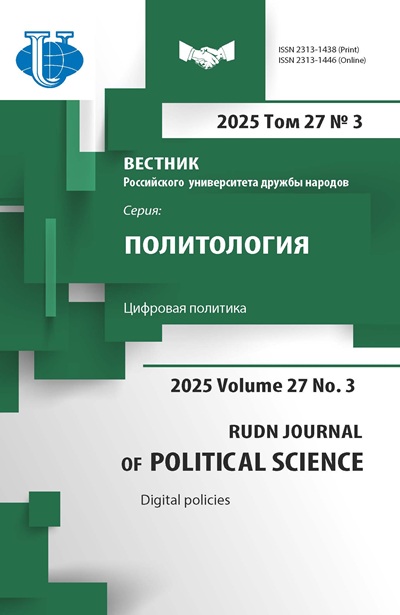Emotional Dynamics in Russian-Language Telegram Channels: Between Cohesion and Affective Polarization
- Autores: Sinitsina A.V.1, Soloviev V.A.1, Tyapkin D.I.1
-
Afiliações:
- HSE University
- Edição: Volume 27, Nº 3 (2025): Digital policies
- Páginas: 444-458
- Seção: POLITICS ONLINE
- URL: https://journal-vniispk.ru/2313-1438/article/view/348829
- DOI: https://doi.org/10.22363/2313-1438-2025-27-3-444-458
- EDN: https://elibrary.ru/OMXHHJ
- ID: 348829
Citar
Texto integral
Resumo
This study proposes a novel methodological framework for analyzing key socio-psychological processes, namely in-group cohesion and affective polarization, within digital media during crises. By examining emotional dynamics in Russian-language Telegram channels (2.5k channels, 1.2M messages) across month preceding and following the onset of the Special Military Operation (SMO), we demonstrate an asymmetric transformation: intensified positive consolidation within ideologically aligned communities alongside heightened intergroup polarization, particularly in external engagements. Employing machine learning, text analytics, and network analysis, our work not only captures the specific reaction to the triggering event but also advances social identity theory by highlighting the fundamental role of emotional boundaries in shaping digital communities. These insights retain critical relevance for understanding social media dynamics in contemporary conflicts and societal divisions.
Palavras-chave
Sobre autores
Arina Sinitsina
HSE University
Autor responsável pela correspondência
Email: a.sinitzina2018@yandex.ru
ORCID ID: 0000-0002-1755-2528
Postgraduate of Doctoral School of Political Science, Lecturer
Moscow, Russian FederationValerii Soloviev
HSE University
Email: valerasolovev13951@gmail.com
ORCID ID: 0000-0002-3590-8567
Postgraduate of Doctoral School of Political Science
Moscow, Russian FederationDanila Tyapkin
HSE University
Email: danilati20@gmail.com
ORCID ID: 0009-0000-0249-4591
M.A.
Moscow, Russian FederationBibliografia
- Akhremenko, A.S., Sinitsina, A.V., & Solovev, V.A. (2024). Separation or cohesion? Dynamics of the network structure of political telegram channels: modeling and empirical analysis. Politeia. 3. 59–81. http://doi.org/10.30570/2078-5089-2024-114-3-59-81 EDN: VLMIWE
- Sinitsina А.V. (2025). Measuring and modeling the cohesion effect in Russian-language social media after the start of the special military operation: an analysis of social motivations. Political science (RU), (1), 203–218. http://www.doi.org/10.31249/poln/2025.01.09 EDN: CQVNAE
- Solovev, V.A. (2025). The dynamics of ideological polarization in Russian-language telegram channels: modelling with machine learning methods. Political science (RU), (1), 240–259. http://www.doi.org/10.31249/poln/2025.01.11 EDN: MXKGQO
- Bail, C.A., Brown, T.W., & Mann, M. (2017). Channeling hearts and minds: Advocacy organizations, cognitive-emotional currents, and public conversation. American Sociological Review, 82(5), 1188–1213. https://doi.org/10.1177/0003122417733673
- Berger, J., & Milkman, K.L. (2012). What makes online content viral? Journal of marketing research, 49(3), 192–205. https://doi.org/10.1509/jmr.10.0353
- Blondel, V.D. et al. (2008). Fast unfolding of communities in large networks. Journal of statistical mechanics: theory and experiment, 10(4), 201–220. http://dx.doi.org/10.1088/1742-5468/2008/10/P10008.
- Carkoglu, A., & Kalaycioglu, E. (2009). The Rising Tide of Conservatism in Turkey. New York: Palgrave Macmillan. https://doi.org/10.1057/9780230621534
- Chmiel, A., Sienkiewicz, J., Thelwall, M., Paltoglou, G., Buckley, K., Kappas, A., & Hołyst, J.A. (2011). Collective emotions online and their influence on community life. PloS one, 6(7), 222–240. https://doi.org/10.1371/journal.pone.0022207
- Conover, M., Ratkiewicz, J., Francisco, M., Goncalves, B., Menczer, F., & Flammini, A. (2021). Political Polarization on Twitter. Proceedings of the International AAAI Conference on Web and Social Media, 5(2), 89–96. https://doi.org/10.1609/icwsm.v5i1.14126
- Druckman, J.N., Peterson, E., & Slothuus, R. (2013). How elite partisan polarization affects public opinion formation. American political science review, 107(1), 57–79. https://doi.org/10.1017/S0003055412000500
- Fredrickson, B.L. (2001). The role of positive emotions in positive psychology: The broaden-and-build theory of positive emotions. American psychologist, 56(3), 218. https://doi.org/10.1037//0003-066x.56.3.218
- Granovetter, M.S. (1973). The strength of weak ties. American journal of sociology, 78(3), 1360–1380. http://dx.doi.org/10.1086/225469.
- Gustavsson, G., & Taghizadeh, J.L. (2023). Rallying around the unwaved flag: national identity and Sweden’s controversial Covid strategy. West European Politics, 46(6), 1063–1088. https://doi.org/10.1080/01402382.2023.2186027
- Iyengar, S., Lelkes, Y., Levendusky, M., Malhotra, N., & Westwood, S.J. (2019). The origins and consequences of affective polarization in the United States. Annual review of political science, 22(1), 129–146. https://doi.org/10.1146/annurev-polisci-051117-073034
- Iyengar, S., Sood, G., & Lelkes, Y. (2012). Affect, not ideology: A social identity perspective on polarization. Public opinion quarterly, 76(3), 405–431. https://doi.org/10.1093/poq/nfs038
- Johansson, B., Hopmann, D.N., & Shehata, A. (2021). When the rally-around-the-flag effect disappears, or: when the COVID-19 pandemic becomes “normalized”. Journal of Elections, Public Opinion and Parties. 31, 321–334. https://doi.org/10.1080/17457289.2021.1924742
- Kazun, A. (2016). Framing sanctions in the Russian media: The rally effect and Putin’s enduring popularity. Demokratizatsiya: The Journal of Post-Soviet Democratization, 24(3), 327–350. EDN: YVKVYT
- Mason, L. (2018). Uncivil agreement: How politics became our identity. Chicago: University of Chicago Press.
- McPherson, M., Smith-Lovin, L., & Cook, J.M. (2001). Birds of a feather: Homophily in social networks. Annual review of sociology, 27(1), 415–444. https://doi.org/10.1146/annurev.soc.27.1.415
- Mueller, J.E. (1970). Presidential popularity from Truman to Johnson. American political science review. 64(1), 18–34. https://doi.org/10.2307/1955610
- Pariser, E. (2011). The filter bubble: How the new personalized web is changing what we read and how we think. New York: Penguin Books.
- Petrov, A., Akhremenko, A., & Zheglov, S. (2023). Dual identity in repressive contexts: an agent-based model of protest dynamics. Social Science Computer Review, 41(6), 2249–2273. https://doi.org/10.1177/08944393231159953
- Rogowski, J.C., & Sutherland, J.L. (2016). How ideology fuels affective polarization. Political behavior, 38(4), 485–508. https://doi.org/10.1007/s11109-015-9323-7
- Suhay, E., Klasina, M., & Rivero, G. (2021). Ideology of affluence: Explanations for inequality and economic policy preferences among rich Americans. The Journal of Politics, 83(1), 367-380. https://doi.org/10.1086/709672
- Tajfel, H., & Turner, J.C. (1979). An integrative theory of intergroup conflict. The social psychology of intergroup relations. Monterey: Brooks/Cole.
- Toepfl, F., & Piwoni, E. (2018). Targeting dominant publics: How counterpublic commenters align their efforts with mainstream news. New Media & Society, 20, 2011–2027. https://doi.org/10.1177/1461444817712085
- Tucker, J.A., Guess, A., Barberá, P., Vaccari, C., Siegel, A., Sanovich, S., Nyhan, B. (2018). Social media, political polarization, and political disinformation: A review of the scientific literature. https://dx.doi.org/10.2139/ssrn.3144139
Arquivos suplementares








